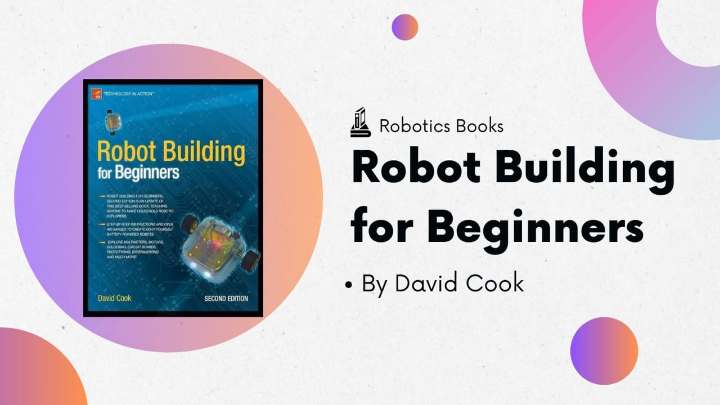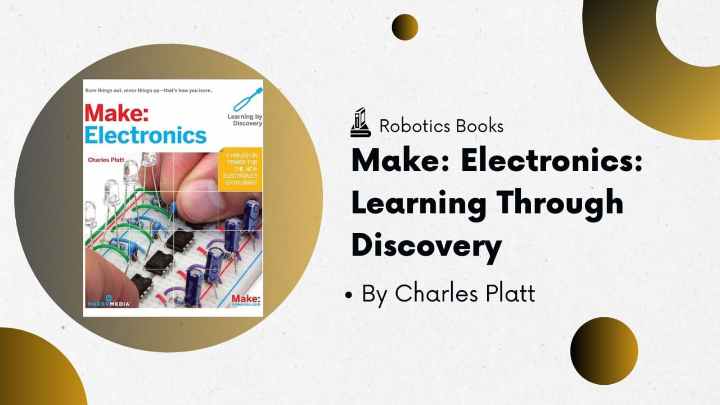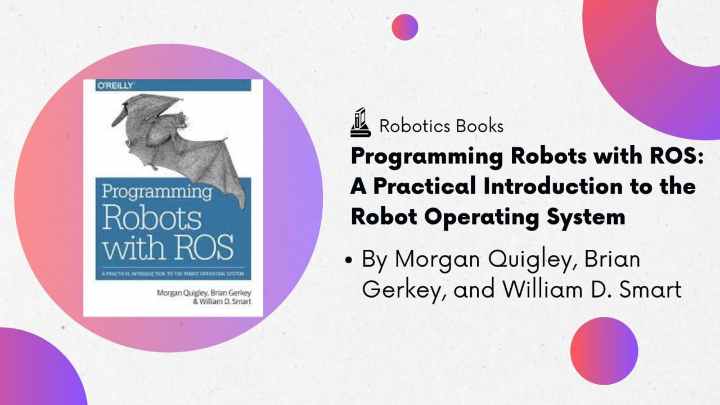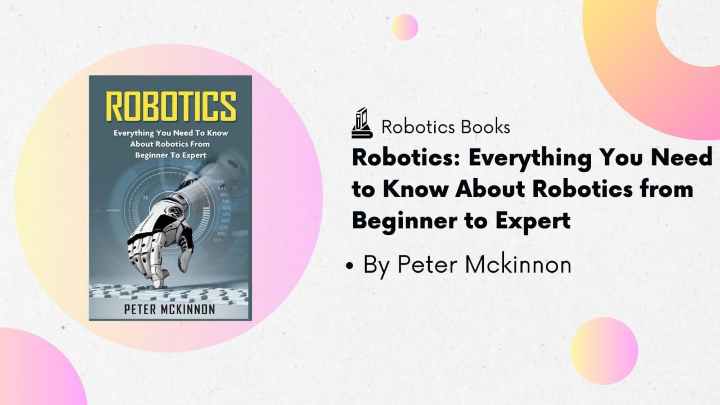Are you looking for the best robotics books for beginners?
Let me guess—you’ve just started your journey into the world of robotics but aren’t sure where to begin.
What could be better than learning robotics from the books written by some of the world’s best roboticists? But with so many options, which book is the best fit for you?
Don’t worry! That’s exactly why I’ve written this article. In this guide, I’ll walk you through some of the best robotics books for beginners.

Table of Contents
Robotics Books for Kids
Now, you might be looking for robotics books for kids and wondering, “Can a child really understand these books? Will they be easy for them?” The answer is yes! Robotics can be complex, but there are some books designed specifically for young minds.
Don’t worry. In this article, I’ve included some books that can be also understood by kids. Yes, they might be a bit challenging, but with a little effort, they can definitely learn from them.
Robotics Books for Middle School
If you’re a middle school student excited about robotics, you’re in the right place! You might be wondering, “Is robotics too complicated for me?” Absolutely not! Middle school is the perfect time to start exploring the basics of how robots work.
With these robotics books for middle school, you’ll be ready to start your journey! Let’s check them out!
List of 10 Best Robotics Books for Beginners:
01. Robot Building for Beginners by David Cook
“Robot Building for Beginners” by David Cook is a great book if you’re just starting your robotics journey. It’s written in a way that even a teenager with no engineering knowledge can understand and learn from it.
You’ll begin with basic tools and gradually progress to prototyping and circuit board soldering. The chapters are filled with hands-on lessons, including topics like multimeters, resistors, LEDs, and DC motors.
The project? An autonomous robot about the size of a lunchbox! Imagine creating a small machine that can explore your home. As you follow along, you’ll build a solid foundation in robotics.

“I wrote this book because I love building robots. I want you to love building robots, too. It took me a while to learn about many of the tools and parts in amateur robotics. Perhaps by writing about my experiences, I can give you a head start.”
David Cook
Bibliographic Information of Robot Building for Beginners by David Cook
| Title | Robot Building for Beginners |
| Author | David Cook |
| Publisher | Apress |
| ISBN-10 | 1430227486 |
| ISBN-13 | 978-1430227489 |
| Page | 453 Pages |
Chapters of Robot Building for Beginners by David Cook
There are 26 chapters in this book.
- Welcome Robot Inventor!
- Where to obtain Tools and Parts
- Safety
- Digital Multimeter
- Numbers and Units
- Robot Line-Following
- Nine-Volt Batteries
- Clips and Test Leads
- Resistors
- LEDs
- Power On!
- Solderless Prototyping
- Solderless Breadboard Setup
- Variable Resistors
- Comparators
- Transistor Switches
- DC Motors
- Adding Gearhead Motors
- Wheels
- Coupler
- Soldering Equipment
- Soldering and Connecting
- The Motherboard
- Body Building
- Launching the Line-Follower
- Encore
02. Make: Electronics: Learning Through Discovery by Charles Platt
Make: Electronics: Learning Through Discovery by Charles Platt is an excellent resource for beginners eager to explore the world of electronics. Platt, a seasoned writer and prototype designer, combines his expertise with a hands-on approach to learning. His passion for electronics began at age 15 when he built a telephone answering machine from surplus parts.
In this second edition, Platt introduces new projects, including a section on Arduino, equipping readers to build circuits and write code. You’ll progress from simple tasks, like lighting up LEDs, to more advanced projects involving microcontrollers.
What I love about this book is how it encourages learning through experimentation—by making mistakes and discovering what happens when components don’t behave as expected. As Hans Camenzind, inventor of the 555 Timer, said of the first edition, “This is teaching at its best!”

Bibliographic Information of Make: Electronics: Learning Through Discovery by Charles Platt
| Title | Make: Electronics: Learning Through Discovery |
| Author | Charles Platt |
| Publisher | Maker Media Inc (17 December 2009) |
| ISBN-10 | 9780596153748 |
| ISBN-13 | 978-0596153748 |
| Page | 334 pages |
Chapters of Make: Electronics: Learning Through Discovery by Charles Platt
There are 5 chapters in this book
- Experiencing Electricity
- Switching Basics and More
- Getting Somewhat More Serious
- Chips, Ahoy!
- What Next
03. Programming Robots with ROS: A Practical Introduction to the Robot Operating System by Morgan Quigley, Brian Gerkey, and William D. Smart
If you’re serious about robotics, this book is a must-read. Programming Robots with ROS simplifies complex robotic tasks, making it a great guide for beginners. The authors take you through the essentials of ROS, an open-source framework that powers many real-world robots today.
One thing I love about this book is the hands-on approach. You don’t just read—you get to build robots that can map, navigate, and even recognize objects. If you’ve ever asked, “How do I program a robot to explore the world?” this book holds the answer.

Bibliographic Information of Programming Robots with ROS: A Practical Introduction to the Robot Operating System by Morgan Quigley, Brian Gerkey, and William D. Smart
| Title | Programming Robots with ROS: A Practical Introduction to the Robot Operating System |
| Author | Morgan Quigley, Brian Gerkey, and William D. Smart |
| Publisher | Shroff/O’Reilly; First Edition (1 January 2016) |
| ISBN-10 | 9352132793 |
| ISBN-13 | 978-9352132799 |
| Language | English |
| Length | 448 pages |
Chapters of Programming Robots with ROS: A Practical Introduction to the Robot Operating System by Morgan Quigley, Brian Gerkey, and William D. Smart
- Introduction
- Preliminaries
- Topics
- Services
- Actions
- Robots and Simulators
- Wander-bot
- Teleop-bot
- Building Maps of the World
- Navigating About the World
- Chess-bot
- Follow-bot
- On Patrol
- Stockroom-bot
- Your Own Sensors and Actuators
- Your Own Mobile Robot
- Your Own Mobile Robot: Part 2
- Your Own Robot Arm
- Adding a Software Library
- Tools
- Debugging Robot Behavior
- The ROS Community: Online Resources
- Using C++ in ROS
04. Robotics: Everything You Need to Know About Robotics from Beginner to Expert by Peter Mckinnon
Robotics: Everything You Need to Know About Robotics from Beginner to Expert by Peter Mckinnon is a perfect guide for anyone who’s curious about how robots work and wants to learn from scratch. The book starts with the history of robotics, covering everything from the very first robots to the essential components that make robots tick today.
One thing I loved about this book is its hands-on approach. You’re not just reading about robots—you’re encouraged to build them! Projects like the Obstacle Avoiding Robot make you feel like a true inventor. If you’ve ever dreamed of programming a robot, this book will get you there.

Bibliographic Information of Robotics: Everything You Need to Know About Robotics from Beginner to Expert by Peter Mckinnon
| Title | Robotics: Everything You Need to Know About Robotics from Beginner to Expert |
| Author | Peter Mckinnon |
| Publisher | Createspace Independent Publishing Platform (28 January 2016) |
| ISBN-10 | 1523731516 |
| ISBN- 13 | 978-1523731510 |
| Language | English |
| Length | 240 Pages |
05. Arduino Robotics by John-David Warren, Josh Adams, and Harald Molle
Arduino Robotics by John-David Warren, Josh Adams, and Harald Molle is a hands-on guide for those looking to dive into building robots with Arduino. You’ll learn about motors, sensors, and how to build motor controllers.
You’ll start with the basics of Arduino, learning how to control motors and create motor controllers. From there, the book walks you through step-by-step projects that range from simple line-following robots to more advanced creations like a robotic lawn mower and a DIY Segway clone. The authors make complex ideas simple, guiding you through real projects like the Battle-Bot or Lawn-Bot 400.
What makes this book stand out is how it combines practical knowledge with creativity, making you feel like an inventor.
Bibliographic Information of Arduino Robotics by John-David Warren, Josh Adams, and Harald Molle
| Title | Arduino Robotics |
| Authors | John-David Warren, Josh Adams, and Harald Molle |
| Publisher | Apress / KP; 1st edition (1 January 2019 |
| ISBN-10 | 1484252144 |
| ISBN-13 | 978-1484252147 |
| Language | English |
| Length | 628 pages |
Chapters of Arduino Robotics by John-David Warren, Josh Adams, and Harald Molle
- The Basics
- Arduino for Robotics
- Let’s Get Moving
- Linus the Line-Bot
- Wally the Wall-Bot
- Making PCB
- The Bug-Bo
- Explorer-Bot
- RoboBoat
- Lawn-Bot 400
- The Seg-Bot
- The Battle-Bot
- Alternate Control
06. Robotics: A Very Short Introduction by Alan Winfield
This book explores how robots have become integral in industries but still haven’t reached the sci-fi expectations many dreamed of decades ago.
Winfield breaks down complex ideas, like how robots are both ordinary and extraordinary at the same time. He compares robot parts to biological systems—like a robot’s camera to an animal’s eyes—which makes it easier for beginners to grasp the concepts.
He also highlights the current state of robotics. He talks about how robots are used in factories, homes, and even space exploration. But, he doesn’t shy away from discussing the gap between our sci-fi expectations and today’s reality. It’s a short read, but you’ll walk away with a deeper understanding of how robots work and what they might be capable of in the future.
Bibliographic Information of Robotics: A Very Short Introduction by Alan Winfield
| Title | Robotics: A Very Short Introduction |
| Author | Alan Winfield |
| Publisher | Oxford University Press; 1st edition (November 17, 2012) |
| ISBN-10 | 9780199695980 |
| ISBN-13 | 978-0199695980 |
| Language | English |
| Length | 143 pages |
Chapters of Robotics: A Very Short Introduction by Alan Winfield
- What is a robot?
- What robots do now
- Biological robotics
- Humanoid and android robot
- Robot swarms, evolution, and symbiosis
- Robotic futures
07. Introduction to Autonomous Robots: Mechanisms, Sensors, Actuators, and Algorithms by Nikolaus Correll
If you’re fascinated by autonomous robots, Introduction to Autonomous Robots by Nikolaus Correll is a must-read. This book is perfect for upper-level undergraduates. The step-by-step approach makes complex ideas, like sensors and neural networks, easier to grasp. It’s perfect for those with a bit of math and programming background.
What makes it special is its balance between hardware (think sensors and actuators) and software (like algorithms for vision). Correll doesn’t just throw you into the deep end. Instead, he takes you through real-world examples and progressive exercises, making complex ideas easy to grasp. Plus, the book includes handy online resources like videos and simulations to bring the theory to life.
Bibliographic Information of Introduction to Autonomous Robots: Mechanisms, Sensors, Actuators, and Algorithms by Nikolaus Correll
| Title | Introduction to Autonomous Robots: Mechanisms, Sensors, Actuators, and Algorithms |
| Author | Nikolaus Correll |
| Publisher | MIT Press |
| ISBN-10 | 0262047551 |
| ISBN-13 | 978-0262047555 |
| Language | English |
| Length | 360 pages |
- Introduction
- Locomotion, Manipulation and Their Representations
- Kinematics
- Forces
- Grasping
- Actuators
- Sensors
- Vision
- Feature Extraction
- Artificial Neural Network
- Task Execution
- Mapping
- Path Planning
- Manipulation
- Uncertainty and Error Propagation
- Localization
- Simultaneous Localization and Mapping
08. Robotics Using Python by Lentin Joseph
Learning Robotics Using Python is an excellent book for those wanting to explore robotics using a popular, accessible language. Lentin Joseph breaks down complex concepts into simple steps, making it easier for beginners to understand. You’ll start by learning the fundamentals of robotics and move on to designing and programming your own autonomous robot.
Using Python and frameworks like ROS (Robot Operating System), Joseph teaches you how to simulate, build, and control robots from scratch. The book even explores using sensors, actuators, and artificial intelligence to add advanced features to your robot.
By the end of the book, you’ll know how to design a robot, integrate AI, and create a GUI-based control system—all in Python.
Bibliographic Information of Learning Robotics Using Python by Lentin Joseph
| Title | Learning Robotics Using Python |
| Author | Lentin Joseph |
| Publisher | Packt Pub Ltd (30 May 2015) |
| ISBN-10 | 1783287535 |
| ISBN-13 | 978-1783287536 |
| Language | English |
| Page | 303 pages |
Chapters of Learning Robotics Using Python by Lentin Joseph
- Introduction to Robotics
- Mechanical Design and Service Robot
- Working with Robot Simulation using ROS and Gazebo
- Designing ChefBot Hardware
- Working with Robotic Actuators and Wheel Encoders
- Working with Robotic Sensors
- Programming Vision Sensors Using Python and ROS
- Working with Speech Recognition and Synthesis Using Python and ROS
- Applying Artificial Intelligence to ChefBot Using Python
- Integration of ChefBot Hardware and Interfacing it into ROS, Using Python
- Designing a GUI for a Robot Using Qt and Python
- The Calibration and Testing of ChefBot
09. Hacking Electronics: An Illustrated DIY Guide for Makers and Hobbyists by Simon Monk
If you’re someone who loves to experiment with electronics, Hacking Electronics: An Illustrated DIY Guide for Makers and Hobbyists by Simon Monk is a must-read. It takes a hands-on approach, teaching you how to hack and modify everyday devices. You’ll learn how to solder, wire components, and even work with transistors and LEDs.
What makes this book unique is its accessibility—it’s packed with colorful illustrations and diagrams that make learning fun and easy. You’ll find yourself building and modifying cool projects, from simple audio amps to complex sensor systems.
With this guide, you’ll be re-purposing everyday devices and creating innovative projects in no time. If you’re searching for the best robotics books for beginners, this one definitely stands out!
Bibliographic Information of Hacking Electronics: An Illustrated DIY Guide for Makers and Hobbyists by Simon Monk
| Title | Hacking Electronics: An Illustrated DIY Guide for Makers and Hobbyists |
| Author | Simon Monk |
| Publisher | McGraw-Hill Education TAB (16 May 2013) |
| ISBN-10 | 0071802363 |
| ISBN-13 | 978-0071802369 |
| Language | English |
| Page | 304 Pages |
Chapters of Hacking Electronics: An Illustrated DIY Guide for Makers and Hobbyists by Simon Monk
- Getting Started
- Theory and Practice
- Basic Hacks
- LEDS
- Batteries and Power
- Hacking Arduino
- Hacking with Modules
- Hacking with Sensors
- Audio Hacks
- Mending and Breaking Electronics
10. Introduction to Robotics: Mechanics and Control by John J. Craig
Introduction to Robotics: Mechanics and Control by John J. Craig is a classic in the world of robotics education since its first release in 1986. This book is a comprehensive guide for those studying mechanical engineering, electrical engineering, or computer science, combining key concepts from all three fields.
Craig breaks down complex topics like rigid-body transformations, kinematics, and robot dynamics into understandable sections. It’s a well-balanced mix, with material split between traditional mechanical engineering concepts, control theory, and computer science. I found the chapters on manipulator kinematics and dynamics especially useful when I started learning about robotic arms.
Bibliographic Information of Introduction to Robotics: Mechanics and Control by John J. Craig
| Title | Introduction to Robotics: Mechanics and Control |
| Author | John J. Craig |
| Publisher | Pearson; 3rd edition (27 July 2004) |
| ISBN-10 | 0201543613 |
| ISBN-13 | 978-0201543612 |
| Page | 408 pages |
Chapters of Introduction to Robotics: Mechanics and Control by John J. Craig
- Introduction
- Spatial descriptions and transformation
- Manipulator kinematics
- Inverse manipulator kinematics
- Jacobians: velocities and static forces
- Manipulator dynamics
- Trajectory generation
- Manipulator-mechanism design
- Linear control of manipulators
- Nonlinear control of manipulators
- Force control of manipulators
- Robot programming languages and systems
- Off-line programming systems
Conclusion:
In the ever-evolving landscape of technology, the doors to robotics are wide open for curious minds to explore. These top 10 “robotics books for beginners” will provide the perfect launching pad for your journey. Whether you dream of building your own robot companion, automating tasks, or simply grasping the fundamentals – these volumes offer a true essence of knowledge.
Don’t let your passion for innovation gather dust on the shelf. Immerse yourself in these beginner-friendly guides and unlock a world where imagination and engineering intersect. The future of robotics awaits your creation – which of these books will unlock your trailblazing vision? Let the adventures in robot making begin!









